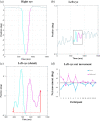Proprioceptive contribution to oculomotor control in humans
- PMID: 36135800
- PMCID: PMC9582377
- DOI: 10.1002/hbm.26080
Proprioceptive contribution to oculomotor control in humans
Abstract
Stretch receptors in the extraocular muscles (EOMs) inform the central nervous system about the rotation of one's own eyes in the orbits. Whereas fine control of the skeletal muscles hinges critically on proprioceptive feedback, the role of proprioception in oculomotor control remains unclear. Human behavioural studies provide evidence for EOM proprioception in oculomotor control, however, behavioural and electrophysiological studies in the macaque do not. Unlike macaques, humans possess numerous muscle spindles in their EOMs. To find out whether the human oculomotor nuclei respond to proprioceptive feedback we used functional magnetic resonance imaging (fMRI). With their eyes closed, participants placed their right index finger on the eyelid at the outer corner of the right eye. When prompted by a sound, they pushed the eyeball gently and briefly towards the nose. Control conditions separated out motor and tactile task components. The stretch of the right lateral rectus muscle was associated with activation of the left oculomotor nucleus and subthreshold activation of the left abducens nucleus. Because these nuclei control the horizontal movements of the left eye, we hypothesized that proprioceptive stimulation of the right EOM triggered left eye movement. To test this, we followed up with an eye-tracking experiment in complete darkness using the same behavioural task as in the fMRI study. The left eye moved actively in the direction of the passive displacement of the right eye, albeit with a smaller amplitude. Eye tracking corroborated neuroimaging findings to suggest a proprioceptive contribution to ocular alignment.
Keywords: extraocular muscles; eye; human; oculomotor; proprioceptive; visual.
© 2022 The Authors. Human Brain Mapping published by Wiley Periodicals LLC.
Conflict of interest statement
The authors declare no conflict of interest.
Figures


References
Publication types
MeSH terms
Grants and funding
LinkOut - more resources
Full Text Sources

